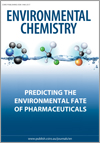EN18154Using laboratory incubations to predict the fate of pharmaceuticals in aquatic ecosystems
Environmental context. Environmental persistence of excreted pharmaceuticals in aquatic ecosystems is usually predicted using small-scale laboratory experiments assumed to simulate natural conditions. We studied five pharmaceuticals comparing their removal rates from water under laboratory conditions and under natural environmental conditions existing in a large pond. We found that the laboratory conditions did not fully capture the complexity within the pond, which led to different removal rates in the two systems.





